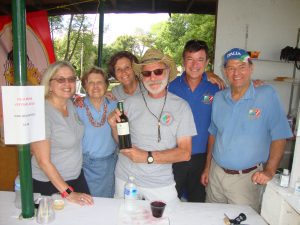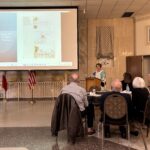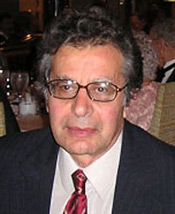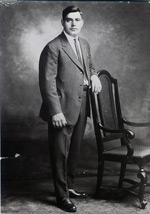Fostering the Heritage of Abruzzo & Molise
 The Abruzzo and Molise Heritage Society of the Washington, D.C. area was established in June 2000 by a small group of Abruzzesi and Molisani (natives and descendants of immigrants) who eventually settled in the Washington, D.C. area.
The Abruzzo and Molise Heritage Society of the Washington, D.C. area was established in June 2000 by a small group of Abruzzesi and Molisani (natives and descendants of immigrants) who eventually settled in the Washington, D.C. area.
Although the community of Italians and Italian-Americans in the Washington D.C. area is rather modest, it has a relatively large number of Abruzzesi and Molisani who recognized the need to foster the cultural heritage of these two regions specifically, as well as Italy broadly.
The Society welcomes anyone who has an interest in preserving and sharing in the rich traditions and values that are unique to Abruzzo, Molise, and to Italy in general to join!
[section]LATEST POSTS
 A Grandson’s Quest for Real Poncio - At the beginning of 2022, I was at a crossroads as my Bachelor’s program was coming to an end, and I was not certain of my next steps... About six months later, shortly after my 22nd birthday, I packed one giant suitcase and moved to Torino.
A Grandson’s Quest for Real Poncio - At the beginning of 2022, I was at a crossroads as my Bachelor’s program was coming to an end, and I was not certain of my next steps... About six months later, shortly after my 22nd birthday, I packed one giant suitcase and moved to Torino. Along the Shepherds’ Tracks: Traturri and Transumanza - The AMHS annual wine tasting, held November 17, 2024, featured a return visit by Zachary Casagrande, who was back by popular demand after giving a very well-received talk in November 2023.
Along the Shepherds’ Tracks: Traturri and Transumanza - The AMHS annual wine tasting, held November 17, 2024, featured a return visit by Zachary Casagrande, who was back by popular demand after giving a very well-received talk in November 2023. Influential Novelist and Screenwriter John Fante - Part of the “magic of the movies” is undoubtedly the musical score which swells below the images and heightens our emotional response to the story unfolding on the screen. One of the most talented practitioners of this special art is Michael Giacchino.
Influential Novelist and Screenwriter John Fante - Part of the “magic of the movies” is undoubtedly the musical score which swells below the images and heightens our emotional response to the story unfolding on the screen. One of the most talented practitioners of this special art is Michael Giacchino. CASTEL DI IERI - By Nancy DeSanti Province of L’Aquila, Region of Abruzzo The beautiful small town of Castel di Ieri is located in the province of L’Aquila. It hasapproximately 326 inhabitants, known as Casteldieresi.Situated on a small hill dominated by a massive tower of the 15th century, it has typicalmedieval houses, together with the Church of the Assumption with a beautiful Renaissanceportal. The majestic tower in the form of a pyramid dominates the most ancient part ofthe village, allowing a panoramic view of the zone. The houses constructed outside of thewalls were constructed at the end of the 19th century.The history of Castel di Ieri dates back to the 7th and 8th centuries B.C. Not far away,there were found relics of pre-Roman times. The city, known as Catrum Hilare, PerioCastle, and also Iesio Castle, was a fiefdom of the Barberini family.In 1522, Castel di Ieri was destroyed by a great fire but was soon reconstructed due to theefforts of the community. In 1860, the town was annexed to the Kingdom of Italy, and in1927 it was created as the municipality of Castel di Ieri. During the second world war, thetown was occupied by the Germans from 1943 to 1944 and suffered extensive damage andlooting.The cultural patrimony of Castel di Ieri is considered very rich. Among the mainattractions there are the Tower of the Castle and the Cathedral of Saint Mary Assumed intoHeaven. Every year, on the occasion of the feast of the patron saint, there are organizedfestivals, concerts, theater spectacles, and sporting events. In addition, every year theretakes place the Prosciutto di Castel di Ieri festival, during which one is able to taste localspecialties and typical products of the zone.Castel di Ieri is a very beautiful little town where a peron is able to spend time intranquility, surrounded by the beauty of nature and thee cultural patrimony. Due to itsgeographical position, to the pleasant climate, and to the rich history, Castel di Ieri offers tothe visitors the opportunity to immerse themselves in an authentic Abruzzese environment,rich in traditions and natural beauties. What to See Church of Saint Mary Assumed into Heaven Tower of the 15th Century Important Dates Sources: https://en.wikipedia.org/wiki/Castel_di_Ierihttps://www.italyheritage.com/regions/abruzzo/laquila/casteldiieri.htmhttps://www.italyheritage.com/regions/abruzzo/laquila/casteldiieri.htmhttps://terredamare.com/comuni/castel-di-ieri Italiano Tradotto da Ennio Di Tullio Provincia di L’Aquila, Regione Abruzzo La bella cittadina di Castel di Ieri si trova in provincia di L’Aquila. Conta circa 326abitanti, noti come Casteldieresi.Situata su una piccola collina dominata da una massiccia torre del XV secolo, ha tipichecase medievali, insieme alla Chiesa dell’Assunta con un bel portale rinascimentale. Lamaestosa torre a forma di piramide domina la parte più antica del paese, consentendo unavista panoramica della zona. Le case costruite fuori dalle mure furono costruite alla finedel XIX secolo.La storia di Castel di Ieri risale al VII e VIII secolo a.C. Non lontano, sono stati trovatiresti di epoca preromana. La città, nota come Catrum Hilare, Castello di Perio, ed ancheCastello di Iesio, era un feudo della famiglia Barberini.Nel 1522 Castel di Ieri fu distrutto da un grande incendio ma fu presto ricostruito dovutoagli sforzi della comunità. Nel 1860, il paese fu annesso al Regno d’Italia, e nel 1927 fucreato come il comune di Castel di Ieri. Durante la seconda guerra mondiale, il paese fuoccupato dai tedeschi dal 1943 al 1944 e subì ingenti danni e saccheggi.Il patrimonio culturale di Castel di Ieri è considerato molto ricco. Tra le principaliattrazioni ci sono la Torre del Castello e la Cattedrale di Santa Maria Assunta in Cielo.Ogni anno, in occasione della festa del santo patrono, vengono organizzate sagre, concerti,spettacoli teatrali, ed eventi sportivi. Inoltre, ogni anno si svolge la sagra del Prosciutto diCastel di Ieri, durante che si possono gustare specialità locali e prodotti tipici della zona.Castel di Ieri è una bellissima cittadina dove una person possa trascorrere del tempoin tranquillità, circondati dalla bellezza della natura e del patrimonio culturale. Dovutoalla sua posizione geografica, al clima piacevole, e alla ricca storia, Castel di Ieri offreai visitatori l’opportunità di immergersi in un autentico ambiente abruzzese, ricco ditradizioni e bellezze naturali. Attrazioni del luogo:Chiesa di Santa Maria Assunta in Cielo Torre del XV secolo Date da ricordare:21 giugno – Prosciutto Fiera 7 agosto – Festa di San Donato 2-3 settembre – Fiera Mercato Summer 2025
CASTEL DI IERI - By Nancy DeSanti Province of L’Aquila, Region of Abruzzo The beautiful small town of Castel di Ieri is located in the province of L’Aquila. It hasapproximately 326 inhabitants, known as Casteldieresi.Situated on a small hill dominated by a massive tower of the 15th century, it has typicalmedieval houses, together with the Church of the Assumption with a beautiful Renaissanceportal. The majestic tower in the form of a pyramid dominates the most ancient part ofthe village, allowing a panoramic view of the zone. The houses constructed outside of thewalls were constructed at the end of the 19th century.The history of Castel di Ieri dates back to the 7th and 8th centuries B.C. Not far away,there were found relics of pre-Roman times. The city, known as Catrum Hilare, PerioCastle, and also Iesio Castle, was a fiefdom of the Barberini family.In 1522, Castel di Ieri was destroyed by a great fire but was soon reconstructed due to theefforts of the community. In 1860, the town was annexed to the Kingdom of Italy, and in1927 it was created as the municipality of Castel di Ieri. During the second world war, thetown was occupied by the Germans from 1943 to 1944 and suffered extensive damage andlooting.The cultural patrimony of Castel di Ieri is considered very rich. Among the mainattractions there are the Tower of the Castle and the Cathedral of Saint Mary Assumed intoHeaven. Every year, on the occasion of the feast of the patron saint, there are organizedfestivals, concerts, theater spectacles, and sporting events. In addition, every year theretakes place the Prosciutto di Castel di Ieri festival, during which one is able to taste localspecialties and typical products of the zone.Castel di Ieri is a very beautiful little town where a peron is able to spend time intranquility, surrounded by the beauty of nature and thee cultural patrimony. Due to itsgeographical position, to the pleasant climate, and to the rich history, Castel di Ieri offers tothe visitors the opportunity to immerse themselves in an authentic Abruzzese environment,rich in traditions and natural beauties. What to See Church of Saint Mary Assumed into Heaven Tower of the 15th Century Important Dates Sources: https://en.wikipedia.org/wiki/Castel_di_Ierihttps://www.italyheritage.com/regions/abruzzo/laquila/casteldiieri.htmhttps://www.italyheritage.com/regions/abruzzo/laquila/casteldiieri.htmhttps://terredamare.com/comuni/castel-di-ieri Italiano Tradotto da Ennio Di Tullio Provincia di L’Aquila, Regione Abruzzo La bella cittadina di Castel di Ieri si trova in provincia di L’Aquila. Conta circa 326abitanti, noti come Casteldieresi.Situata su una piccola collina dominata da una massiccia torre del XV secolo, ha tipichecase medievali, insieme alla Chiesa dell’Assunta con un bel portale rinascimentale. Lamaestosa torre a forma di piramide domina la parte più antica del paese, consentendo unavista panoramica della zona. Le case costruite fuori dalle mure furono costruite alla finedel XIX secolo.La storia di Castel di Ieri risale al VII e VIII secolo a.C. Non lontano, sono stati trovatiresti di epoca preromana. La città, nota come Catrum Hilare, Castello di Perio, ed ancheCastello di Iesio, era un feudo della famiglia Barberini.Nel 1522 Castel di Ieri fu distrutto da un grande incendio ma fu presto ricostruito dovutoagli sforzi della comunità. Nel 1860, il paese fu annesso al Regno d’Italia, e nel 1927 fucreato come il comune di Castel di Ieri. Durante la seconda guerra mondiale, il paese fuoccupato dai tedeschi dal 1943 al 1944 e subì ingenti danni e saccheggi.Il patrimonio culturale di Castel di Ieri è considerato molto ricco. Tra le principaliattrazioni ci sono la Torre del Castello e la Cattedrale di Santa Maria Assunta in Cielo.Ogni anno, in occasione della festa del santo patrono, vengono organizzate sagre, concerti,spettacoli teatrali, ed eventi sportivi. Inoltre, ogni anno si svolge la sagra del Prosciutto diCastel di Ieri, durante che si possono gustare specialità locali e prodotti tipici della zona.Castel di Ieri è una bellissima cittadina dove una person possa trascorrere del tempoin tranquillità, circondati dalla bellezza della natura e del patrimonio culturale. Dovutoalla sua posizione geografica, al clima piacevole, e alla ricca storia, Castel di Ieri offreai visitatori l’opportunità di immergersi in un autentico ambiente abruzzese, ricco ditradizioni e bellezze naturali. Attrazioni del luogo:Chiesa di Santa Maria Assunta in Cielo Torre del XV secolo Date da ricordare:21 giugno – Prosciutto Fiera 7 agosto – Festa di San Donato 2-3 settembre – Fiera Mercato Summer 2025 Siamo Una Famiglia - Sunny Day on the C&O Canal Enjoying a sunny day along the canal on May 3 were: (l to r) Carmine Spellane, Maria Panetta Fanelli, John Fanelli (with their dog Lucca, named after the city in Tuscany), Albert Palantonio, AMHS Board Member Teresa Black, Dominique Renneker, and AMHS President Chris Renneker. A small but hardy band of AMHS members and friends gathered in the Georgetown neighborhood of Washington, D.C., on the morning of May 3 for a short hike along the C&O Canal towpath. The cool morning gave way to a warm, sunny day. After about two hours, the group returned to the heart of Georgetown to the popular Italian restaurant Il Canale for lunch. The hike has now become an annual event.hristopher Renneker, our AMHS president, will be going to the Italian-American Future Leaders convention in Florida in January. Chris’ application to the Class of 2025 was accepted and he will be joining a network of young leaders and professionals from across the United States. May Event Postponed The AMHS’ scheduled event in May was postponed to be rescheduled at a later date. The event was to be held in conjunction with Casa Italiana and Holy Rosary Church to highlight the monthly briscola games and other activities. Look for an announcement on the new date. Summer 2025
Siamo Una Famiglia - Sunny Day on the C&O Canal Enjoying a sunny day along the canal on May 3 were: (l to r) Carmine Spellane, Maria Panetta Fanelli, John Fanelli (with their dog Lucca, named after the city in Tuscany), Albert Palantonio, AMHS Board Member Teresa Black, Dominique Renneker, and AMHS President Chris Renneker. A small but hardy band of AMHS members and friends gathered in the Georgetown neighborhood of Washington, D.C., on the morning of May 3 for a short hike along the C&O Canal towpath. The cool morning gave way to a warm, sunny day. After about two hours, the group returned to the heart of Georgetown to the popular Italian restaurant Il Canale for lunch. The hike has now become an annual event.hristopher Renneker, our AMHS president, will be going to the Italian-American Future Leaders convention in Florida in January. Chris’ application to the Class of 2025 was accepted and he will be joining a network of young leaders and professionals from across the United States. May Event Postponed The AMHS’ scheduled event in May was postponed to be rescheduled at a later date. The event was to be held in conjunction with Casa Italiana and Holy Rosary Church to highlight the monthly briscola games and other activities. Look for an announcement on the new date. Summer 2025 A Message from the President - Greetings! The year 2025 is the 25th anniversary of the founding of the Abruzzo and Molise Heritage Society! I am very proud of all we have accomplished over the last 25 years and the steps we are taking to make sure we will have a successful 25 more years.In honor of this milestone, we are collecting the stories of our founding members and immigrant members from our regions. These stories will be used for an event later in the year. Also to celebrate our anniversary, we are creating a digital archive which will be accessible via our new webpage later this year.In addition, we will be attempting to have two yearly events that highlight a unique element of Abruzzo or Molise. Our first regional event will be by past president Maria D’Andrea on the Transumanza/Tratturi. This event is not only a unique part of the patrimony of Abruzzo but also the last event before Maria relocates to Asheville, N.C. I would like to encourage everyone to make it to this event. We hope for this presentation to be one of our best attended events to send Maria off in a fitting celebration of our culture.I would also like to welcome our two new board members, Natasha Rovo and Teresa Black. They have both already contributed much to the Society this year. In addition to serving on the board, Natasha is the chair of the publications, publicity, web site, & social media committee, and Teresa is the chair of the programs & hospitality committee. In addition, immediate past president Raymond LaVerghetta is the chair of the scholarship and fundraising subcommittees.We have several happy hours, a hike, online events, and a May general meeting to look forward to.I hope everyone has had a great new year so far, and I look forward to seeing you all soon! Chris Renneker March/April 2025
A Message from the President - Greetings! The year 2025 is the 25th anniversary of the founding of the Abruzzo and Molise Heritage Society! I am very proud of all we have accomplished over the last 25 years and the steps we are taking to make sure we will have a successful 25 more years.In honor of this milestone, we are collecting the stories of our founding members and immigrant members from our regions. These stories will be used for an event later in the year. Also to celebrate our anniversary, we are creating a digital archive which will be accessible via our new webpage later this year.In addition, we will be attempting to have two yearly events that highlight a unique element of Abruzzo or Molise. Our first regional event will be by past president Maria D’Andrea on the Transumanza/Tratturi. This event is not only a unique part of the patrimony of Abruzzo but also the last event before Maria relocates to Asheville, N.C. I would like to encourage everyone to make it to this event. We hope for this presentation to be one of our best attended events to send Maria off in a fitting celebration of our culture.I would also like to welcome our two new board members, Natasha Rovo and Teresa Black. They have both already contributed much to the Society this year. In addition to serving on the board, Natasha is the chair of the publications, publicity, web site, & social media committee, and Teresa is the chair of the programs & hospitality committee. In addition, immediate past president Raymond LaVerghetta is the chair of the scholarship and fundraising subcommittees.We have several happy hours, a hike, online events, and a May general meeting to look forward to.I hope everyone has had a great new year so far, and I look forward to seeing you all soon! Chris Renneker March/April 2025 A Joyful Carnevale - The AMHS annual wine tasting, held November 17, 2024, featured a return visit by Zachary Casagrande, who was back by popular demand after giving a very well-received talk in November 2023.
A Joyful Carnevale - The AMHS annual wine tasting, held November 17, 2024, featured a return visit by Zachary Casagrande, who was back by popular demand after giving a very well-received talk in November 2023. The Future of Italian-American Leadership - This past January, Chris Renneker attended the Italian-American Future Leaders Conference as a fellow. This event brings together hundreds of young Italian Americans from around North America to network and learn best practices to help bring Italian-American organizations into the future.
The Future of Italian-American Leadership - This past January, Chris Renneker attended the Italian-American Future Leaders Conference as a fellow. This event brings together hundreds of young Italian Americans from around North America to network and learn best practices to help bring Italian-American organizations into the future.  Former Secretary of State Mike Pompeo - Part of the “magic of the movies” is undoubtedly the musical score which swells below the images and heightens our emotional response to the story unfolding on the screen. One of the most talented practitioners of this special art is Michael Giacchino.
Former Secretary of State Mike Pompeo - Part of the “magic of the movies” is undoubtedly the musical score which swells below the images and heightens our emotional response to the story unfolding on the screen. One of the most talented practitioners of this special art is Michael Giacchino. Montenero Val Cocchiara - The small town of Rotello is located about 30 kilometers (19 miles) northeast of Campobasso. in the province of Campobasso. It has about 1,190 inhabitants, called Rotellesi.
Montenero Val Cocchiara - The small town of Rotello is located about 30 kilometers (19 miles) northeast of Campobasso. in the province of Campobasso. It has about 1,190 inhabitants, called Rotellesi.
WITH THANKS TO ROMEO SABATINI AND RYAN TURNER


The Society dedicates its website to Romeo Sabatini, who worked tirelessly for over 10 years developing and maintaining our original site; and to Ryan A. Turner who, in honor of his grandmother Rosemarie Antonelli Turner (whose father Frank emigrated from Abruzzo), gifted the Society with funds to develop this new site. The Society is grateful for Romeo’s time and for Ryan’s generosity, which bridge the past with the future for the benefit of all AMHS members and friends.
[/section]